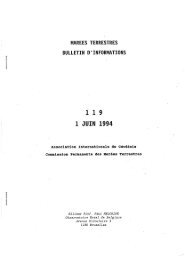marees terrestres bulletin d'informations - Université de la Polynésie ...
marees terrestres bulletin d'informations - Université de la Polynésie ...
marees terrestres bulletin d'informations - Université de la Polynésie ...
Create successful ePaper yourself
Turn your PDF publications into a flip-book with our unique Google optimized e-Paper software.
A New Tidal Gravity Station at Hurghada, Red Sea, Egypt<br />
R. M. Hassan 2 , K. H. Zahran 1 , G. Jentzsch 2 and A. Weise 2<br />
1National Research Institute of Astronomy and Geophysics, Helwan, Egypt<br />
2 Friedrich- Schiller- University, Institute of Geosciences, Jena, Germany<br />
Abstract<br />
The Red Sea region is one of the seismically active regions in Egypt due to the tectonic<br />
movements in the Red Sea. The evaluation of the seismic activity and recent crustal<br />
movements in this region is an important point of scientific interest. The LaCoste and<br />
Romberg gravimeter D-218 was installed in the tidal gravity station on the ground floor of the<br />
main building of the Seismological Centre at Hurghada, Red Sea, Egypt. One year of<br />
continuous gravity observations (February 2008 to February 2009) are avai<strong>la</strong>ble to conduct<br />
the current study. The main objectives are to <strong>de</strong>termine the response of the crust to the tidal<br />
forces and, in consequence, to supply reductions for the geo<strong>de</strong>tic observations, which were<br />
initiated due to the continuous seismological activities in this region. The tidal parameters of<br />
Hurgada station have been <strong>de</strong>termined by least squares adjustment and the standard <strong>de</strong>viation<br />
of the analysis is ±5.6 nm/s 2 . The residuals reach about 20 nm/s². The amplitu<strong>de</strong> spectrum<br />
shows a noise level in the diurnal band of 5.5 nm/s² and 6 nm/s² in the semidiurnal band.<br />
1. Introduction<br />
Hurghada city is located in a seismically active area close to the triple junction of the African<br />
p<strong>la</strong>te, Arabian p<strong>la</strong>te and Sinai sub-p<strong>la</strong>te. The boundaries of these three p<strong>la</strong>tes are seismically<br />
active and are represented by three seismic source zones: the northern part of Red Sea, the<br />
southern part of Gulf of Suez and the Gulf of Aqaba seismic zones (Fig. 1). The National<br />
Research Institute of Astronomy and Geophysics (NRIAG) has established a seismic network<br />
(ENSN) to study the seismic activity and a geo<strong>de</strong>tic network to monitor the recent crustal<br />
movements. Thus, a tidal gravity station at Hurghada is of great importance in this region. In<br />
the gulf areas and shelf regions usually a <strong>la</strong>teral change of the tidal constituents is observable<br />
due to the complicated tidal wave propagation against the boundary of the shelf and the<br />
influence of the bottom and coastal friction in shallow water areas. The anomalous behavior<br />
of the tidal constituents in Gulf regions has ma<strong>de</strong> the accurate prediction of ti<strong>de</strong>s in these<br />
regions of consi<strong>de</strong>rable importance for various geophysical, geo<strong>de</strong>tic and oceanographic<br />
applications. NRIAG has successfully established tidal gravity stations at both Cairo ( Zahran<br />
et. Al, 2004) and Aswan (Hassan, 2007 ; Hassan et al., 2009 a & b). An additionl tidal gravity<br />
station has been established at the ground floor of the main building of Hurghada<br />
seismological center to achieve a higher accuracy for geo<strong>de</strong>tic and geophysical observations,<br />
so high precaution in the observation and advanced analysis technique has to be applied.<br />
2. Objectives of Hurghada Tidal Gravity Station<br />
The objectives of Hurghada tidal gravity station are summarized as follows:<br />
a- Carrying out continuous gravity observations to <strong>de</strong>termine the local e<strong>la</strong>stic parameters<br />
of the Earth's crust to the tidal forces;<br />
b- Providing Earth ti<strong>de</strong> reductions for gravity measurements and other precision<br />
measurements (satellite positioning and leveling);<br />
c- Determining the observed ocean ti<strong>de</strong> loading parameters<br />
d- Comparing the recent ocean ti<strong>de</strong> mo<strong>de</strong>ls with the observed ocean ti<strong>de</strong> loading<br />
11847



